This thought took me back to my couch in Chiang Mai as a familiar memory began playing in my mind. The couch's backrest cushion was askew, lying out-of-place against the seat of the couch. As I stared at the askew cushion, I could feel a deep yearning in my heart to be on the back of the couch. The cushion, dare I say, wanted to be back in its rightful place, on the back of the couch. I could even see an energetic pull between the cushion and the back of the couch.
That experience had haunted me for years. Why did the cushion want to be on the back of the couch? How did it know it belonged on the back of the couch? Why there, specifically? It was such a strange question to ponder, and certainly one that I never voiced out loud. One does not simply question the desires of a cushion without risking admittance to a mental institution.
And yet there I was, pondering the question all over again in a new light. Truth be told, under the cloak of anonymity, I'd posted on the private forum of my energy school, hoping that someone might offer me some clarity. The school's head instructor replied a few hours later, saying, "The designer of the couch intended for the cushion to sit on the back of the couch. That's why it wanted to return to that spot."
Hmm…
A new connection fired in my brain. "Cushions are like fish," I muttered as I clicked through the open tabs in my browser, trying to locate the research paper I'd read a short while ago: The free energy principle for action and perception: A mathematical review. I found the passage in question and re-read it.
Essentially, the [Free Energy Principle] generalises these results by noting that all (viable) biological organisms resist a tendency to disorder as shown by their homoeostatic properties (or, more generally, their autopoietic properties), and must therefore minimise the occurrence of events which are atypical (‘surprising’) in their habitable environment. For example, successful fish typically find themselves surrounded by water, and very atypically find themselves out of water, since being out of water for an extended time will lead to a breakdown of homoeostatic (autopoietic) relations. Because the distribution of ‘surprising’ events is in general unknown and unknowable, organisms must instead minimise a tractable proxy, which according to the FEP turns out to be ‘free energy’. Free energy in this context is an information-theoretic construct that (i) provides an upper bound on the extent to which sensory data is atypical (‘surprising’) and (ii) can be evaluated by an organism, because it depends eventually only on sensory input and an internal model of the environmental causes of sensory input.
Christopher L. Buckley, Chang Sub Kim, Simon McGregor, Anil K. Seth
I grabbed a piece of paper and a pen from my desk, then drew a diagram.
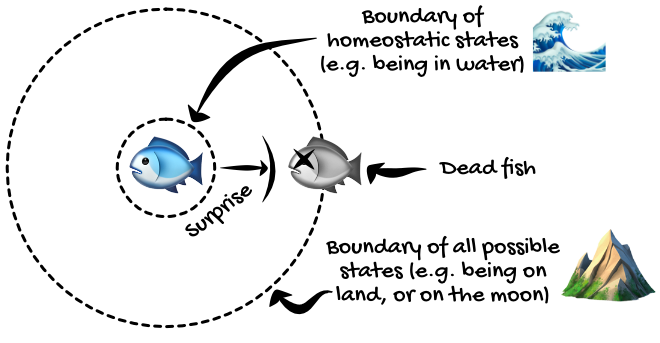
I imagined myself as a fish, swimming around in the water, existing in a state of homeostasis. All the evidence around me confirmed my own belief that I was a fish. Since I was having a physical experience of being a living fish, the probability that I'd find myself out of water (and therefore in a surprising state) was low. As I ventured into surprising states (for example, leaving the water), the probability that I would die, and therefore no longer be experiencing myself as a living fish, approached one. Hence, all living fish restricted themselves to states that maximized evidence that they are who they believe themselves to be — namely, a living fish.
I drew another diagram, this time replacing the fish with the cushion from the couch.
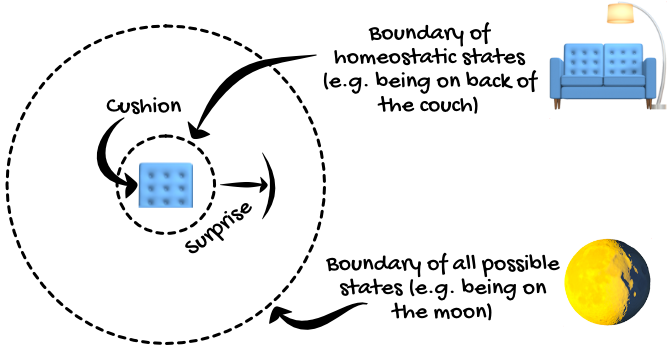
I imagined myself as a couch cushion. To have a physical experience of being a couch cushion, I'd need to restrict myself to states that maximized evidence that I am who I believe myself to be — namely, a cushion that belongs on the back of the couch. Therefore, the further I moved away from the back of the couch, the greater the surprise I would experience. To me, as a cushion, being askew or on the floor was the equivalent of being a fish out of water.
But that's stupid, my mind rebutted. Cushions can't move themselves.
I blinked a few times in realization.
Exactly! Cushions can't move themselves. But other agents can move cushions.
I drew another diagram, this time with two agents in the system: the cushion, and my friend, Pandora — a neat and organized individual. The cushion on the couch was askew, and therefore in a state of surprise. Pandora was observing the cushion, whose out-of-place position contradicted her self-concept as a neat person — and therefore also put her in a state of surprise.
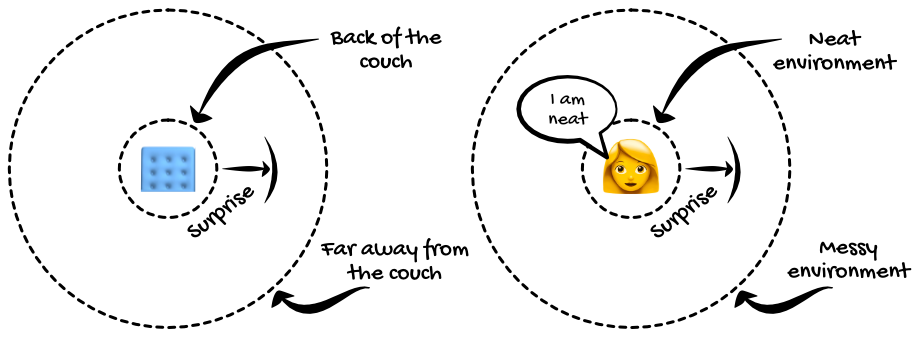
The combination of these two interacting observers created a buildup of free energy that threw the system out of homeostasis. The cushion was in a surprising state because it should be on the back of the couch (in the same way that a fish should be in water). And Pandora believed herself to be a neat person, so the out-of-place cushion also placed her in a surprising, lower-probability state.
To minimize this surprise, an impulse was 'injected' into Pandora's consciousness: tidy up the cushion. She acted on that impulse by returning the cushion to the back of the couch. Homeostasis was restored. The cushion maximized evidence for its own self-concept ('I am a backrest cushion'), and so did Pandora ('I am a neat person').
Hmm…
I ran the thought experiment in my mind again, but changed one variable: instead of being a neat freak, Pandora now believed herself to be a messy person.
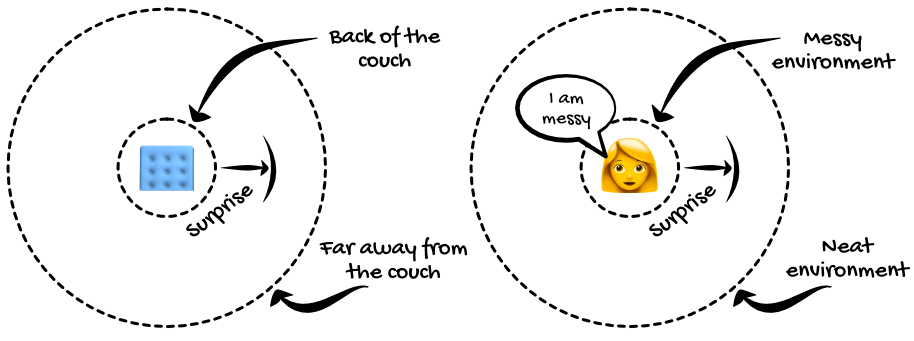
This slight modification to Pandora's self-concept completely changed the free energy distribution in the system. Pandora no longer felt an impulse to tidy the cushion and return it to the back of the couch where it belonged, because that would place the system in a surprising state. If she tidied the cushion, the data entering her senses would say 'I am neat,' while her internal model of reality believes 'I am messy,' thus throwing the system out of homeostasis.
That's why the cushion remained askew, even though it wanted to be on the back of the couch. The cushion couldn't move itself to the back of the couch, because doing so represented an unparsimonious route through mutual expectation. Pandora would get a huge prediction error if she suddenly saw a cushion moving by itself!
Hmm…
I ran the experiment one last time with a different configuration. Pandora believed herself to be a neat and tidy person again. The cushion, on the other hand, was lying on the floor of the apartment — right where the designer originally intended it to be. According to this model, placing couch cushions on the floor was now an accepted 'neat' thing to do, and therefore the system was in homeostasis — despite the cushion being on the floor. I drew a diagram to represent the new system.
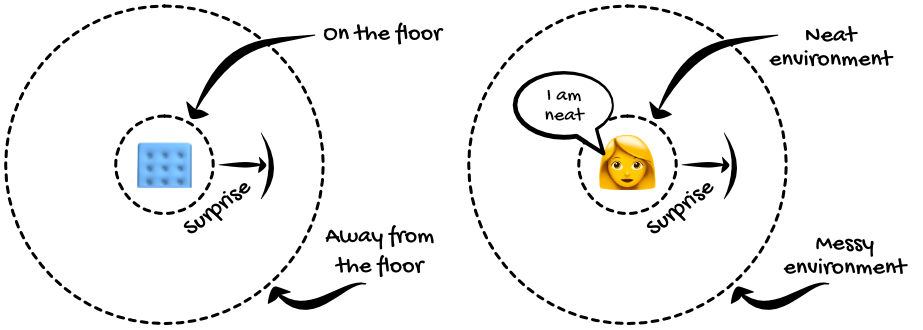
As I drew the diagram, I noticed the changing definition of the word 'messy.' If the cushion was on the floor, the room was now 'neat.' If the cushion was on the back of the couch, the was now 'messy,' and therefore in a low-probability state — like a fish out of water.
I watched the simulation run. Pandora glanced at the cushion on the floor and did nothing. She believed herself to be a neat person, and the cushion was in its intended 'neat' place on the floor. Therefore, the system was in homeostasis. The only difference between this simulation and the previous one was a change of intention; a belief. The designer's intention for the cushion affected the probability that the cushion would manifest at any particular point in space. It also affected the ideas and impulses that were injected into Pandora's mind. The universe changed due to the intention of the cushion's designer.
Hmm...
This series of simulations exposed a fascinating concept. To minimize the free energy in the system, Pandora had been given an idea — an idea that she thought was coming from her own brain, but really served a grander purpose. Not only did her impulses minimize her own free energy, but they also minimized the cushion's free energy and the free energy of the system as a whole.
I remembered back to five years ago, lying in my bed at night after the failure of 99dresses, trying to understand why things had turned out the way they did. When I traced the whole experience back to first principles, I realized that my own ideas, impulses, thoughts, and intuition were the catalyst for everything. They had changed the entire trajectory of my life, but I had no idea where they came from.
Now, after five years of persistence, the answers were starting to emerge. There was nothing random about my thoughts or my ideas. There was nothing random about my imagination, or what I was passionate or curious about. There was nothing random about the big dreams and desires that had been placed inside my heart, or my intense — sometimes puzzling — impulses and intuition. Everything that I thought was me, was actually just a small fragment of a mathematical mosaic. I was simultaneously an agent in my own life and a soldier in an emergent universal system, carrying out some kind of grand cosmic surprise-minimizing masterplan.

